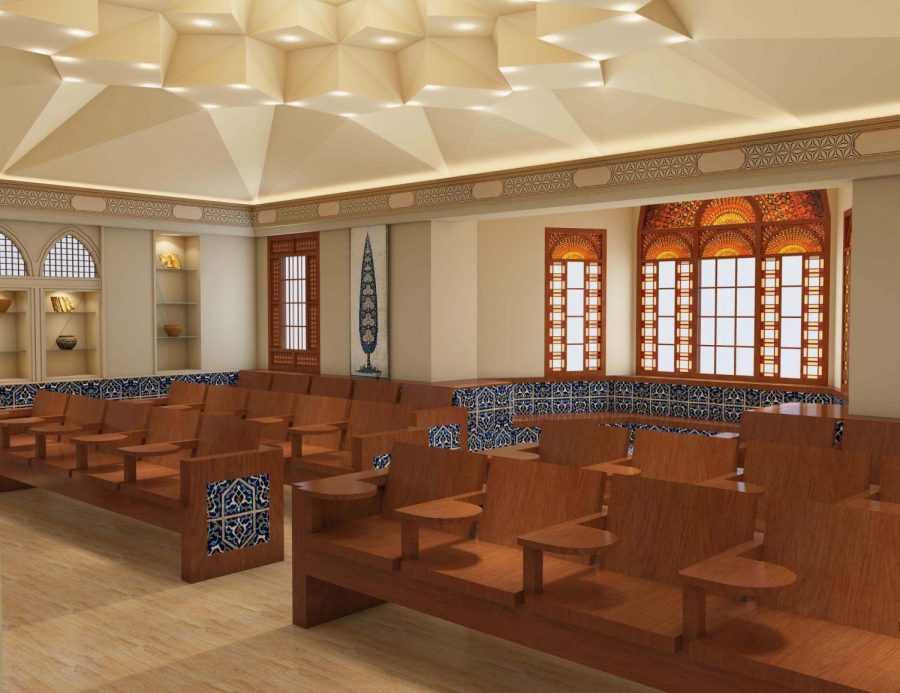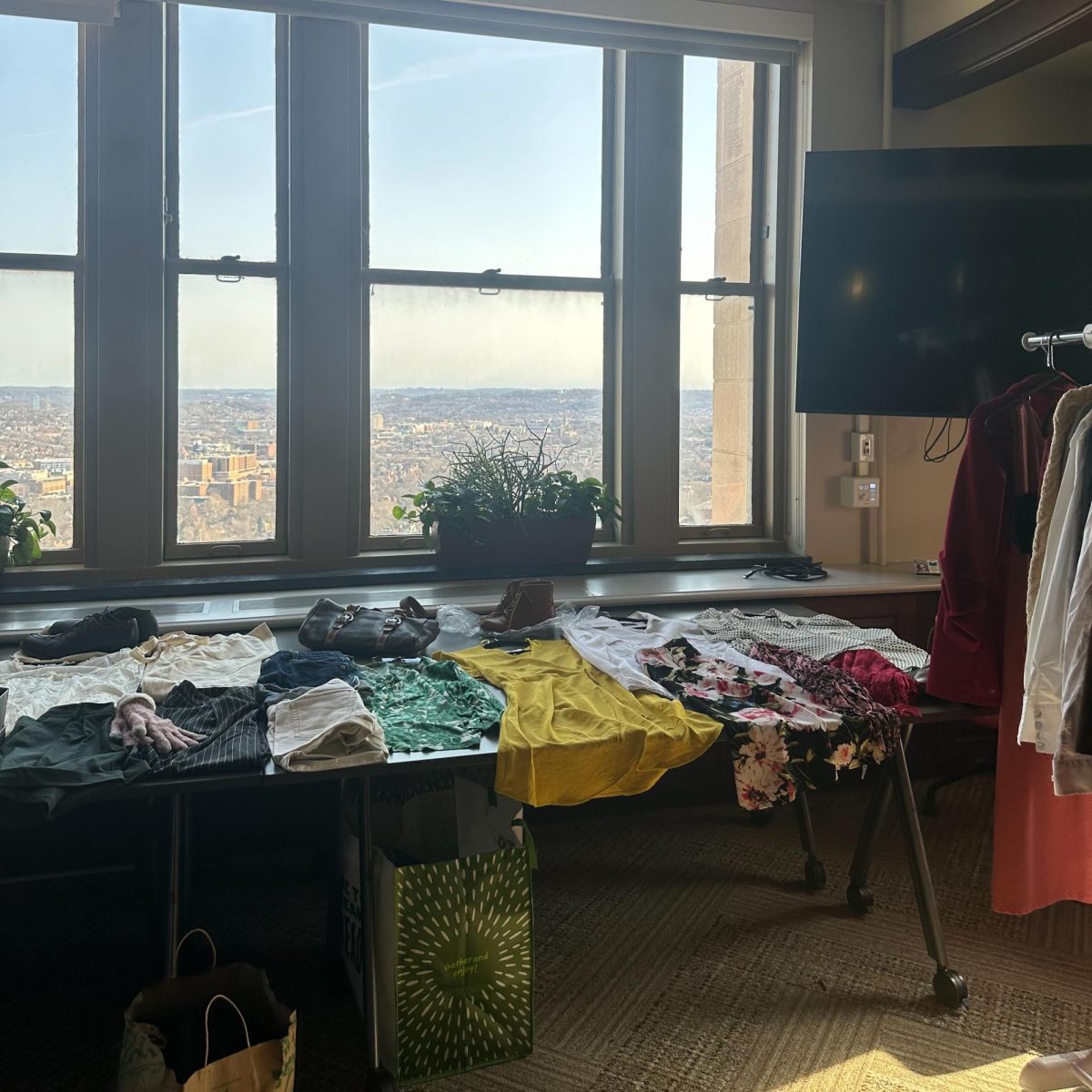Pitt to revisit plans for Finnish, Iranian rooms
Photo courtesy of Maryann Sivak
The Finnish and Iranian (pictured) Nationality Rooms are in the fundraising process and will be coming to the Cathedral within the next few years.
March 3, 2020
Rooms 306 and 351 look like regular classrooms right now — but all Nationality Rooms have to start somewhere.
These rooms are the future sites of the Finnish room and the Iranian room, which may join the Austrian room, the German room, the Japanese room and others among the current 31 Nationality Rooms in the Cathedral of Learning sometime in the next few years. Construction on the rooms was supposed to start this year, following five-year plans implemented by Pitt and the rooms’ respective committees in 2015 — but fundraising efforts have not been moving as quickly as planned.
The Finnish and Iranian rooms will most likely be due for a review of their progress with the University in August, according to Maryann Sivak, the assistant to the director of the Nationality Rooms. Pitt will then decide whether to revise the project timeline originally set in each of the plans.
Sivak said there traditionally has not been a set timeline for room construction — in the past, it depended on how successful committees were with their fundraising. Some Nationality Rooms have taken long periods of time to fundraise.
“The Korean Heritage room took about seven years to complete, while the recently opened Philippine Nationality room took roughly 20 years to complete,” Sivak said.
The University originally assigned room 306, currently a regular, functioning classroom, to be the Finnish room in 2003. Its committee is headed by Seija Cohen, a Finland native. The Iranian room, approved five years ago, will be in room 351, which is currently blocked off. Its committee is headed by Ali Masalehdan, president of Masimex, a medical supply company.
Under their agreed plan with Pitt, the Iranian and Finnish rooms’ respective committees are supposed to finish fundraising, followed by construction, within 10 years from the start of the project. The committees must submit their fundraising plans to Pitt and are required to evaluate the amount of support from the respective communities involved. Construction will only begin when the fundraising stage is complete.
As of late February, the Finnish committee has raised $100,000 of its $400,000 goal. The Iranian committee has raised less than half of its $800,000 to $1,000,000 goal. Both rooms have struggled with raising sufficient funds for various reasons and said they will likely renew the plan with the University to allow for more time to fundraise.
Cohen said there have been some barriers to fundraising for the Finnish room due to the size of the Finnish community in Pittsburgh and the increasing cost of the room, which has risen by about $100,000 in the last few years. The Finnish room committee has used various fundraising methods over the past 17 years to reach its current amount, after beginning with $5,000.
“Our own local Finnish community in Pittsburgh is very small and many of our members are here on a temporary basis, which presents a special challenge when we are faced with trying to complete a project,” Cohen said.
Masalehdan said his committee has also faced fundraising troubles. The Iranian committee fundraised by holding picnics and soliciting funds from the Iranian community.
“We started with very high hopes. I guess [the] political environment is not very conducive to things Iranian these days,” Masalehdan said. “People aren’t as open as they were before three years ago or so.”
Masalehdan said fundraising is also difficult because local Iranians are not prioritizing the Nationality Room — they are more concerned about their relatives back home.
“Many [in Iran] depend on funds coming from relatives and friends in the U.S.,” Masalehdan said.
Both planned rooms will show traditional architecture from their respective countries. The Iranian room, designed by Nader Ardalan, a former Harvard professor and prominent Iranian architect, will feature architecture based on a historic mansion in Kashan.
“This unique architecture features a traditional wind tower, vaulted geometric domes, carved stucco and adobe decorations,” Sivak said.
While the Iranian room will boast a more grand design, Sivak said the Finnish room, designed by Steve Altherr, will depict the type of log farmhouse where children were taught before school buildings became available.
“Since the 1600s, Finnish immigrants have brought this building art with them to America and built their log houses, many of which are still standing,” Sivak said. “The Finnish log farmhouse evokes this heritage and the contributions Finns have made in the fields of education, architecture, art and technology.”
In order for these designs to be realized, the committees still have to get through the difficult fundraising stage.
Masalehdan said the Iranian committee plans to renew the five year plan and continue to fundraise, seeking supporters among Iranians and Iranian Americans in Pittsburgh. He said the Iranian room committee will begin a more aggressive fundraising campaign this year and has added a new board member focused on marketing.
Cohen added that the Finnish room committee will change up its fundraising strategy a bit going forward. The committee submitted a grant proposal to the Finnish Expatriate Parliament and used a database through the Carnegie Library to find more than 100,000 potential funding sources.
“We intend to visit other Finnish associations in Detroit, Michigan, and Fitchburg, Massachusetts, respectively, where we can disseminate Finnish room information and solicit support from individuals, groups, and businesses in locations with larger Finnish-American populations,” Cohen said.
Cohen said the committee will continue working toward the room for as long as it can.
“We will continue celebrating the Finnish cultural heritage and its values,” Cohen said. “We believe that it has left a deep imprint in the American history and it will always be remembered.”
Masalehdan said it “would be wonderful” for students to take classes in an Iranian room and that the committee will achieve its goal eventually.
“When you walk in there, you see all these great cultures and it’s missing another great culture, which is Iran,” Masalehdan said. “The University is supportive, they’re just waiting with us for a sunnier day.”



